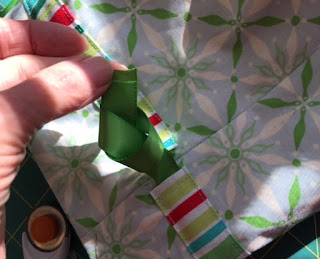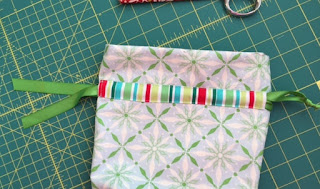 |
| Finished size: 12" x 9" x 3". |
It's been a three day marathon, but the new purse is finally finished.
I've had requests for a pattern, and I'm going to give it a bit of a try on this blog. I've never produced a pattern for a bag because it's always seemed overwhelming. Unfortunately, I sew a bit like I make soup. I start out with a vague idea and a few basic measurements - sort of. Then I toss things together as I go and wait to see what happens.
I'm warning you now. This is a learning experience. I hope it won't be a huge disaster!
Please, please tell me if any part of this tutorial needs to be corrected or clarified!
I'll give instructions for the entire outside of the bag, but I'm not quite sure how, or even if, I'll deal with the inside details. You see, I was so focused on finishing the bag that I forgot to take important photos for the recessed zipper and the pockets in the lining. I have measurements for a basic lining with no recessed zipper, so that may have to do. Unfortunately, my hubby's right about me. I can be a total scatter brain. But, the lining and zipper are tales to be told much later. Or not. Or, then again, I just might have to make a second purse. Oh, dear. That's so sad. (said the lady with a grin)
Today, it's all about the front pocket.
The Front Pocket
(These measurements are generous. It's better to have extra fabric for your stash than is is to run short.)
- 1 1/2 yard of lining. This will be used for the handles and sides of the bag as well as the inside lining.
- 3/4 yard contrasting fabric for the recessed zipper and for the front and back sections of the bag.
- A 11" x 11" square of a third fabric for the pocket insert.
- Scraps for hexagons.
- 3/4 yard of bag batting such as Soft and Stable.
- An 9" x 12" piece of lightweight batting such as Warm and Natural.
- One small magnetic snap.
- One 18" nylon zipper for top of the bag. (Nylon zippers can be cut if they are too long.)
- One 9" zipper for the lining.
- 1 yard medium weight fusible interfacing. (This is to add stability to the lining.)
- Thread
- (optional) Invisible polyester thread.
Note: Seam allowances are 1/2" unless otherwise specified.
Make the Hexagons
Make three hexagon that finish at 2 1/2" wide . I used a hexagon ruler to make a template. The hexagon that finishes 2" in height is perfect, but only if you use the 2 1/2" high cutting lines for the finished size.
You can sew the hexagons on any way you like. Fusible web applique would be fine. That's my usual approach. This time, though I wanted my purse to be a bit special, so I experimented with a quick technique that is supposed to look like hand applique. It was scary, but it worked perfectly, so that's the method I've shown here.
1. Make three templates from freezer paper.
2.. Starch the fabric to make it very stiff before cutting it. I used an inexpensive spray starch from the supermarket.
3. Lay the freezer paper shiny side up on the wrong side of the fabric. I put a dot of quilt basting glue between the freezer paper and the fabric to hold it all in place temporarily.
4. If you're planning to turn edges under, cut the fabric 1/4" larger than the freezer paper template on all six sides.
5. Fold the edges down against the template one side at a time, and iron onto the shiny side of the freezer paper.
6. Carefully remove the freezer paper, then give the hexagon a really good press. When you do, press straight down and give it a good burst of steam! Flip to the other side and press again. Moving the iron back and forth will distort the shape. I know because I've lived to regret it. More than once. We scatterbrains do things like that.
7. Cut out an 8 1/2" x 11" rectangle of fabric for the pocket front.
8. Center the hexagons with their top edges 1 1/2" below the top edge of the pocket front. Line the hexagons up in a row with the side points just touching. Use pins or quilt basting glue to hold them in place for sewing. I used a dab of glue stick on each corner and in the center of each hexagon.
9. Stitch the hexagons in place. This was the new part for me. I used invisible polyester thread and a shell tuck stitch. A very narrow zigzag stitch would work just as well, but I only recently discovered this stitch on my machine. I did have to reverse it. Love this new Babylock!
The second photo shows the stitch length and width. My choice was for short and narrow.
I stitched right along the edge of the hexagon. The straight stitches are just outside the applique, and the little inward stitches barely catch the edge. I was surprised that this really went so smoothly. Zip-zip, and done.
Look how clean that edge is! You have to get very close to tell that it hasn't been hand stitched in place. Giggle!
Make the Pocket Front.
1. Cut a 10" x 11" rectangle of fabric for the pocket lining.
2. Cut a piece of batting 8 1/2" x 11".
A heavier batting such as Soft and Stable is great for most of the bag, but the pocket needs a thinner batting, like Warm and Natural. Cut a piece of your thin batting to fit the pocket. Attach it to the wrong side of the pocket with quilt basting spray.
Note: I used a quilt basting spray and a quilt marking pen. These are my standbys - June Taylor spray and a Frixion pen. The spray holds things together lightly so you can reposition everything easily. My lovely pen erases with the touch of a hot iron.
3. Place the pocket front and the lining right sides together. Use a 1/4" seam allowance to sew along the top of the pocket through all three layers. Press the seam up to the lining.
4. I added the first half of a magnetic snap next. With the pocket sections open, mark a point in the exact center of the lining and 1 3/4" down from the seam. Attach the magnetic snap to the right side of the lining at this mark. Push the prongs through the right side of the lining and then through a scrap of folded fabric on the wrong side of the lining.
5. Fold the lining over the batting and to the back of the pocket front. Do not fold the batting down. The 1/2" strip of lining that remains on the top of the pocket looks like binding, but is much easier to make than binding would be. (Photos found below will be helpful in seeing this.)
6. Baste around the outside edges of the layers pocket front, batting, and binding. Stitch right against the seam where the lining meets the front of the pocket.
7. Quilt however you like.
I used a diamond design that lined up with the hexagons. A 60 degree triangle ruler helped to keep the lines straight and even.
 |
| Right Side |
 |
| Lining Side |
The center insert forms the back of the pocket. Later the entire pocket section will be inserted between side pieces on the front of the bag.
1. Cut out the pocket back and a matching piece of your main batting. Soft and Stable was my choice for batting.
2 Use quilt basting spray to hold the batting to the wrong side of the fabric. Quilt as you like.
3. Square up and trim to 10" x 10".
3. Place the pocket on the center insert with the the bottom and side edges together. On the right side of the insert, mark the point where the other half of the snap needs to be placed.
4 Attach the snap with prongs going through the right side of the pocket insert and the batting. Snap the pocket onto the insert.
5. Stay-stitch close to the edge through all layers on the two sides and the bottom. leaving the top of the pocket open.
The finished pocket section including pocket and center insert.
And that's it for now.
Coming Soon: Finishing the outside of the bag.




































